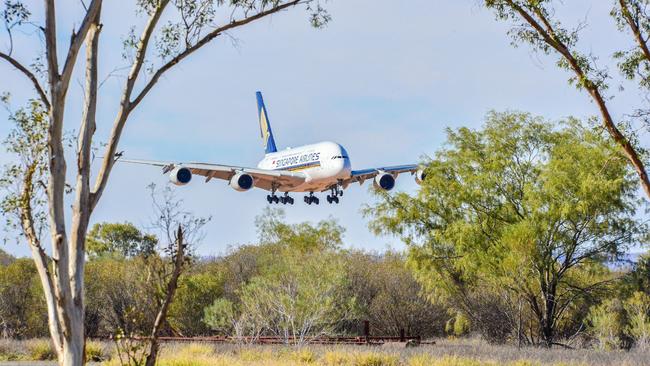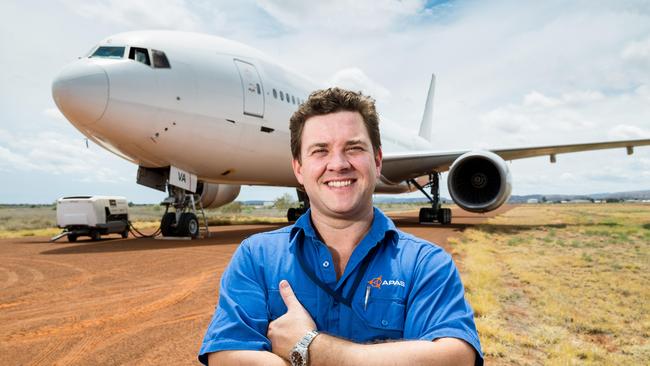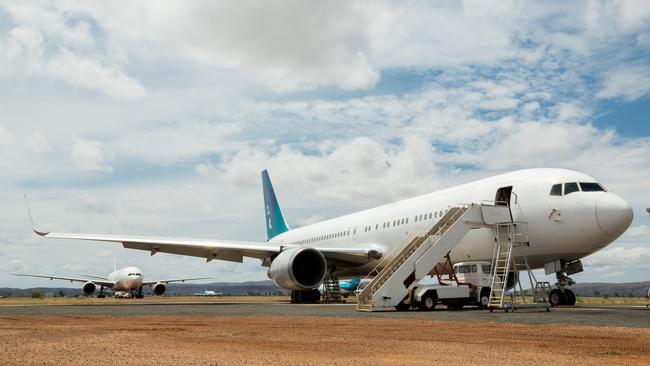Where to store a plane? Ask Alice
A busy aircraft storage facility in Australia’s red centre could well be a barometer for the coronavirus crisis.

A sprawling aircraft storage facility in Australia’s red centre could well be a barometer for the coronavirus crisis — the busier it gets, the worse off the aviation industry is.
When the virus was confirmed in China in January, Asia Pacific Aircraft Storage in Alice Springs held just eight Boeing 737 Max 8s for Singapore Airlines and Fiji Airways.
Fast forward a few months and the number of aircraft at the site has almost tripled to 22, with that figure likely to triple again in the months ahead.
So rapidly is the demand growing, APAS is fast-tracking its stage two and three developments to accommodate as many as 100 aircraft by the end of June.

Managing director Tom Vincent said the expansion would involve building another four roads with a total of 16 “fingers” which he expected to fill with aircraft from airlines throughout the Asia-Pacific.
“Even before this health crisis, we were seeing an increase in demand for aircraft storage,” Mr Vincent said.
“It has certainly accelerated in recent months, which has prompted us to move into stage three much sooner than we thought we would.”
Among the weekend arrivals at the site were two Scoot A320s and four Singapore Airlines A380s.
The superjumbos, worth a total of $2.8bn, were a sight to behold as they thundered down the landing strip to their new home.
“It was probably the most exciting day in our six years of operation,” Mr Vincent said.
“There’s a lot of work upfront to prepare the aircraft for storage and that’s even more so the case with an A380.” Singapore Airlines also has three 777s in storage at Alice Springs, one of several sites being used by the carrier worldwide to ensure its fleet is properly maintained during the pandemic.

“The impact of the COVID-19 outbreak has resulted in significantly reduced demand across the aviation industry and as a result Singapore Airlines has reduced its scheduled capacity by 96 per cent,” Singapore Airlines spokesman Karl Schubert said.
“Of a group fleet of 200 aircraft, only 10 are currently operating on scheduled passenger services.”
Despite speculation the A380 model may not return to commercial operations post-COVID-19, Mr Schubert said the airline would reintroduce the aircraft “when appropriate”.
“We will continue to monitor the situation,” he said.
On Thursday, APAS will welcome two more Boeing 777s from Thailand’s NokScoot, and Mr Vincent was expecting more 777s, A330s and 737NGs in coming weeks.
“There’s a lot more coming from all over (the Asia Pacific),” he said.
For now, Qantas and Virgin Australia do not need the storage site offered by APAS, with airports providing sufficient space for the hundreds of planes not in use.
Most are not charging for parking in recognition of the challenges posed by the pandemic, which last week pushed Virgin Australia into administration, with debts of $6.8bn.
Adding to the airline’s woes, Perth and Adelaide airports have taken possession of aircraft over unpaid debts in the vicinity of $26m.
The first creditors’ meeting of the administration will take place electronically on Thursday.


To join the conversation, please log in. Don't have an account? Register
Join the conversation, you are commenting as Logout